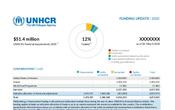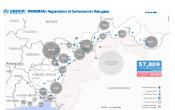Nigeria
Operation: Nigeria
Location
{"longitude":9,"latitude":9,"zoom_level":0,"iso_codes":"'NGA'"}
By clicking on the icons on the map, additional information is displayed.
The boundaries and names shown and the designations used on this map do not imply official endorsement or acceptance by the United Nations.
Key Figures
| 2019 year-end results | |
| 18,200 | women received sanitary materials |
| 5,700 | households received core relief items |
| 4,200 | people of concern received business training |
| 3,400 | people of concern received legal assistance |
| 1,200 | people of concern received training on sexual and gender-based violence prevention and response |
| 2020 planning figures | |
| 100% | of settlement-based refugees (some 20,000 people) will receive 20 litres of potable water per person, per day |
| 97% | of sites where IDPs, IDP returnees and other civilians are threatened by the presence of armed actors will be monitored |
| 80% | of primary school-aged refugee children will be enrolled in primary education |
| 60% | of targeted IDPs in north-east Nigeria (360,000 people) will be provided with birth certificates |
| 24% | of targeted IDP households in north-east Nigeria (14,400 households) will be living in adequate dwellings |
Latest Updates
People of Concern
5%
Decrease in
2019
2019
| 2019 | 2,269,468 |
| 2018 | 2,379,761 |
| 2017 | 2,379,195 |

[["Refugees",54166],["Asylum-seekers",1033],["IDPs",2195779],["Returned IDPs",18356],["Returned refugees",134]]
Loading ...
Nigeria
< Back
2019
{"categories":[2015,2016,2017,2018,2019,2020],"budget":[null,40.906967547,79.767047754,80.40000002000001,93.06523573,90.61282518],"expenditure":[null,21.965234239999997,30.61301372,30.46963491,40.28442153,null]}
{"categories":[2015,2016,2017,2018,2019,2020],"p1":[null,1.82155943,5.94289722,13.36027901,34.6076047,38.70181407],"p2":[null,null,null,null,null,null],"p3":[null,2.831582997,30.23548234,22.89000044,27.08602015,15.06266468],"p4":[null,36.253825119999995,43.588668194,44.14972057,31.37161088,36.84834643]}
{"categories":[2015,2016,2017,2018,2019,2020],"p1":[null,1.18809322,2.46861358,11.30156782,20.0278546,null],"p2":[null,null,null,null,null,null],"p3":[null,1.5415473,15.801339050000001,7.63509863,4.576413929999999,null],"p4":[null,19.235593719999997,12.343061089999999,11.532968460000001,15.680153,null]}
Loading ...
CHOOSE A YEAR
- 2015
- 2016
- 2017
- 2018
- 2019
- 2020
Operational context
Nigeria was party to all the international legal instruments. The country had domesticated the 1951 Refugee Convention but was yet to domestication the Kampala Convention. Humanitarian access was unhindered in principle, but limited in practice by the security situation in the north-east.The security situation in the north-east was fluid due to the ongoing armed conflict between government forces and non-State armed groups (NSAG). There was a farmers-herders conflict in the middle belt and communal clashes, kidnapping, and cattle rustling in the north-west. Crime was a common threat in the rest of the country.
The Government of Nigeria announced pledges at the Global Refugee Forum in December 2019, supporting a “whole of society approach” in the management of refugees and IDPs.
Population trends
As of December 2019, there were some 2.2 million IDPs. In north-west Nigeria, inter-communal clashes resulted in the displacement of over 210,300 people across Katsina, Sokoto and Zamfara States, and forced more than 35,000 refugees to flee into Niger. In north-east Nigeria, due to deteriorating security conditions new waves of displacement increased the overall number of IDPs to 2 million. In the middle belt, some 277,400 people were internally displaced in Benue, Nasarawa and Plateau States, 57% of whom were estimated to be below 18 years old.Nigeria hosted over 51,700 Cameroonian refugees (of which over 14,800 arrived in 2019, an increase of 35% compared to 2018). At the end of 2019, there were more than 2,400 urban refugees and 1,000 asylum-seekers in Lagos, Ogun, Oyo, Kano and Abuja.
Achievements
- Some 2,500 protection monitoring missions were conducted in the north-east of the country, providing information to protection actors.
- UNHCR organized and facilitated the second regional protection dialogue, during which the Governments of Cameroon, Chad, Niger and Nigeria all reaffirmed their commitment to the Abuja Action Statement on the protection of civilians in the Lake Chad Basin.
- Nearly 900 border monitoring missions were conducted, ensuring that there were no cases of refoulement and freedom of movement was guaranteed. An absence of identity cards was identified through these missions.
Unmet needs
- The operation’s budget was funded at 43% by the end of 2019. Of the $4.6 million requested for the IDP response in Nigeria, 0% was received.
- Many refugees were living outside the settlements and development of new settlements stopped.
- More than 90% of IDPs had no documentation.
- More than half of IDP households did not have adequate shelter.
Working environment
Nigeria continues to face a complex humanitarian situation with no end in sight to the Boko Haram insurgency. Although the Nigerian military made significant gains against the insurgents in 2017 and 2018, Boko Haram remains a serious threat to security. So far, IDPs and refugees have only returned to the Local Government Areas headquarters, often resulting in IDP like situations with many returnees living in camps and camp-like situations. Returnees are not authorized to move beyond a security perimeter defined by the military around the headquarter towns. This restriction reduces the capacity of returnees to engage in meaningful livelihood activities. Due to the absence of services and civil authority in areas of return, services like education, health and law enforcement including the security of IDP camps has been assumed by the military. Humanitarian movements to the field are possible only through air transport provided by the humanitarian air service helicopters. In some locations, humanitarian hubs (safe temporary accommodation and work space) were set up to facilitate field missions.Elsewhere in Nigeria, clashes between herdsmen and farmers in the middle belt (Benue, Nasarawa and Taraba states) are on the increase. In 2017 and in the first quarter of 2018, theses clashes generated thousands of IDPs and resulted in several deaths as well as destruction of property and livelihoods. This conflict has been identified as a threat to national security.
The last quarter of 2017 and 2018 saw the arrival of Cameroonian refugees in Nigeria with the majority settling in host communities in Cross River and Benue States. Due to security concerns, the Government of Nigeria has advised the establishment of camps /settlements far from the border areas. These refugees are in addition to some 2,500 refugees and asylum-seekers that were already present in urban areas, mostly in Lagos.
UNHCR will continue to explore and fully utilize opportunities for strategic partnerships with agencies like the World Bank, UNDP, and Presidential committee on the North-east (PCNI) to integrate its programmes into the development strategy and implement activities that are beneficial to both displaced and host communities. UNHCR will continue to strengthen interagency partnership through coordination structures at both state and federal level including the Inter-Ministerial Task Force (IMTF) and the government-led Humanitarian Coordination Working Group (HCWG).
UNHCR’s will continue to lead the Protection Sector Working Groups at Abuja and Maiduguri levels, as well as the Camp Coordination and Camp Management and Shelter/ ShelterNFI Sectors.
Following the signing of the Tripartite Agreement for the return of Nigerian refugees from Cameroon in March 2017, organized return is expected to be a major trend in 2019, in addition to spontaneous return of both non-registered refugees and IDPs from camps to areas of origin.
Key priorities
In 2019, UNHCR will focus on:- continuing to implement a protection-centred operational strategy for IDPs to respond to pressing needs of vulnerable displaced individuals identified during protection monitoring, vulnerability screening and community-based participatory assessments;
- providing IDPs with protection-based material assistance, livelihood assistance and peacebuilding; access to justice; response to sexual and gender-based violence, psychosocial support and advocacy; and child protection;
- Providing core-relief items and shelter assistance, including through cash-based interventions (CBIs), for IDPs
- advocating for increased engagement with government and other humanitarian actors and promote collaboration with development actors to ensure interagency and inter-sectorial complementarities;
- promoting sustainable return of refugees and reduce recourse to negative coping strategies through promoting and stimulating livelihoods and CBIs in the areas prioritized by refugees returnee communities;
- distribution of core relief items, livelihood assistance, shelter interventions to the most vulnerable, access to justice and strengthening peaceful coexistence to the returning refugees;
- integrating CBI components in shelter/NFIs kits, business start-up kits and income generation cooperatives for refugee returnees;
- supporting government counterparts in registration of newly arriving Cameroonian refugees and provision of individual documentation to enhance legal protection;
- continuing to move refugees (on a voluntary basis) to the new settlements in Cross River and Benue states away from the borders and ensuring provision of access to services as well as livelihood support to refugees both within the communities and the settlements;
- working closely with ECOWAS for implementation of agreed plan of action.























